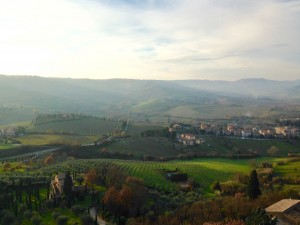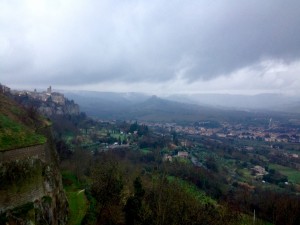The market in Piazza del Popolo has had primroses for the past two weeks. I’ve been waiting for warmer weather to buy them. Today was in the upper-fifties (14℃) so I took the plunge: four euro – three yellow, two fuchsia, one burgundy. Before lunch I cleaned up the planters on the terrazzo, and made room for our new occupants. The valley showed dappled – strong light, strong shadows, bright greens, musky tans.
I also bought tomatoes at the market to go with the mozzarella di bufala I purchased yesterday. The tomatoes are of a kind between roma and cherry and are so sweet and flavorful they cause me to shudder. The mozzarella di bufala makes the stuff I get in Pennsylvania seem like tofu by comparison. I’m told the really good mozzarella di bufala comes from Sicilia. I cannot imagine anything being better, but no one here would dream of lying about food.
 After lunch and Saturday housecleaning, the sun shone again, just for a moment, and it was clearly time for a walk. I set out for San Giovenale. As I reached the walls, sunlight flooded the valley. It was like the cinematic effect of changing from black and white to color. In that light, I was able to closely watch cars and busses as they traced their ways towards Bolsena. They twist back and forth on dramatic switchbacks that never seem so extravagantly wasteful of distance when actually traveling them. I tried to identify places I know. It’s liberating to see familiar spots from such a distance when the only way of actually reaching them (for me, at this time) is on foot. It imbues the roads, the valleys, the unseen spaces over the mountains, with a mythic reality, one that remains hidden when access is easy.
After lunch and Saturday housecleaning, the sun shone again, just for a moment, and it was clearly time for a walk. I set out for San Giovenale. As I reached the walls, sunlight flooded the valley. It was like the cinematic effect of changing from black and white to color. In that light, I was able to closely watch cars and busses as they traced their ways towards Bolsena. They twist back and forth on dramatic switchbacks that never seem so extravagantly wasteful of distance when actually traveling them. I tried to identify places I know. It’s liberating to see familiar spots from such a distance when the only way of actually reaching them (for me, at this time) is on foot. It imbues the roads, the valleys, the unseen spaces over the mountains, with a mythic reality, one that remains hidden when access is easy.
The garden below San Giovenale where the Presepe Vivente was held has yet to be cleared. There are still stacks of firewood, blackened circles from campfires, the ruins of wood and waddle huts, the straw-filled cradle where the holy infant lay, plastic tarps, huge pumpkins. I suppose it will all be gone in time for the first wave of tourists in March. It has perhaps been too cold, and what’s the hurry anyway?
I went down to walk among the ruins. To the right is a fenced yard that sits behind the hall adjoining ex-Sant’Agostino. This is apparently where the night club that briefly occupied that space abandoned its equipment. Stainless steel fixtures are mixed with slabs of marble, squares of tufa, statues, bricks, planters, and a moldy mattress.
Back up at the perimeter wall I watched the flocks of blackbirds and pigeons. The Etruscans of Orvieto are said to have augured the future by observing the movement of birds. I have no predictions from my spellbound twenty or thirty minutes, but I better understand why the ancients may have believed that avian flight patterns bestow access to the unknown.
The flocks play with the wind, silently for a while, then with random notes, then suddenly a symphony, then silence. They move up and down the valley, always a pair breaking away, ahead or to the side, they turn and parade and swoop. Then the individuals land in trees, on roofs, on steeples, like petals on a pond. The blackbirds glide and turn majestically, almost self-conscious in their handsome strength. Pigeons, clowns of the street with their waddling and doppling, are gymnasts of the air. Athletic and graceful, their patterns are precise, compact, imaginative, willful. They land on the sheer face of a cliff as if it were the branch of a tree.
The wind grew strong and cold, so I climbed to the top of the ramparts, loving the wild movement of my hair, and descended into town. It was just then four, and the shops were beginning to reopen. The evening passeggiata had barely begun. Knots of people dotted Piazza Sant’Andrea, individuals and couples sliced across the square, crossing between the arches. I heard recently that Orvieto, the high town, had a population of fifteen thousand until the barracks were decommissioned in 2000, and it now has a population of five thousand. I tried to imagine the moment in front of me with three times the people, but the present was too absorbing for me to conjure a picture.
wild movement of my hair, and descended into town. It was just then four, and the shops were beginning to reopen. The evening passeggiata had barely begun. Knots of people dotted Piazza Sant’Andrea, individuals and couples sliced across the square, crossing between the arches. I heard recently that Orvieto, the high town, had a population of fifteen thousand until the barracks were decommissioned in 2000, and it now has a population of five thousand. I tried to imagine the moment in front of me with three times the people, but the present was too absorbing for me to conjure a picture.
As I passed the flower market, the fellow, who in other times may have been called the village idiot, was in conversation with a family group strolling their baby. He is a frequent presence on the streets, cheerful, energetic, and loving. I’m always happy to see him. He occasionally says hello. It falls on me like a blessing.
The dance of the town moved along at varying rhythms and steps, as a fellow in a colorful poncho and long black hair played guitar and harmonica, and sang. He provided the sound track for the splendid, languid, unexpected spectacle that rocked up and down Corso Cavour.
It often seems to me that one of the most destructive tendencies we humans can fall into is our wanting to possess beauty. We attempt to buy it, capture, wed it, control it, define, and subdue it. In all of that effort, we never seem to succeed in understanding it, or in growing any closer to it. We can, however, quite easily become a part of it. The price of admission is to give up ownership, and we are allowed to stay for as long as we can bear the magnificence.
You don’t have to be in Orvieto, or even a place like it, for free beauty suddenly to present itself, but I am grateful to be here for those moments. It sings to me, this city, and weaves from the simple and ordinary an unfathomable magic that, every surprising time the curtain parts, seems to last forever.